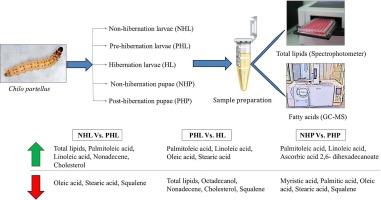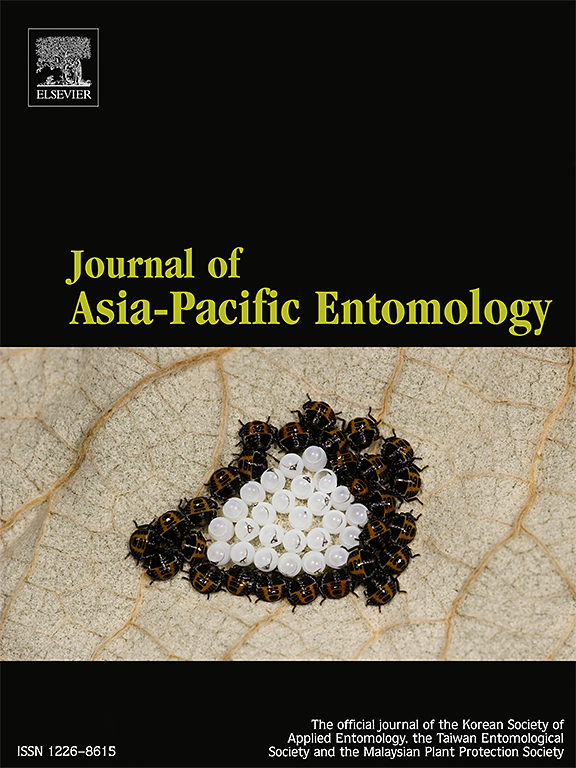Hibernation changes tissue specific lipophilic profile of Chilo partellus (Swinhoe)
IF 1.1
3区 农林科学
Q3 ENTOMOLOGY
引用次数: 0
Abstract
Chilo partellus undergo hibernation to survive under harsh winter conditions. We investigated changes in lipophilic profiles of larval and pupal whole body and tissues (haemolymph, fat bodies and integument) of hibernation and non-hibernation C. partellus strains. Significantly higher amount of lipids was found in whole body of pre-hibernation and hibernation larvae than non-hibernation larvae. At tissue level, total lipids were significantly higher in haemolymph and fat bodies of pre-hibernation, and integument of non-hibernation larvae. In whole body of larvae and pupae of hibernation and non-hibernation strains, most abundant fatty acids were oleic acid (16.4%–23%), palmitic acid (14.6%–19.3%), linoleic acid (9.3%–11.6%), palmitoleic acid (3.7%–7.3%) and stearic acid (1.7%–2.8%). Further, at tissue level, myristic, palmitoleic, palmitic, linoleic and oleic acids in fat bodies; and stearic acid in the integument of hibernation larvae were higher as compared to other body parts and larval stages of C. partellus. In pupal tissues, myristic, palmitic and stearic acids were higher in the haemolymph and fat bodies of non-hibernation pupae than post-hibernation pupae. Among the unsaturated fatty acids (UFAs), the palmitoleic acid significantly increased in all the larval tissues, and linoleic acid in fat bodies and integument, while oleic acid significantly decreased in integument of hibernation as compared to non-hibernation larvae of C. partellus. These information on adaptive remodelling of lipids at tissue level might help in future physiological, molecular, ecological and pest management studies on C. partellus.

冬眠改变了奇洛鱼(Swinhoe)的组织亲脂性特征
奇洛虫(Chilo partellus)通过冬眠在严酷的冬季条件下生存。我们研究了冬眠和非冬眠部分栉水母幼虫和蛹全身及组织(血淋巴、脂肪体和皮肤)亲脂特征的变化。冬眠前和冬眠幼虫全身的脂质含量明显高于非冬眠幼虫。在组织水平上,冬眠前幼虫血淋巴和脂肪体中的总脂类明显高于非冬眠幼虫。在冬眠和非冬眠品系的幼虫和蛹的全身,最丰富的脂肪酸是油酸(16.4%-23%)、棕榈酸(14.6%-19.3%)、亚油酸(9.3%-11.6%)、棕榈油酸(3.7%-7.3%)和硬脂酸(1.7%-2.8%)。此外,在组织水平上,冬眠幼虫脂肪体中的肉豆蔻酸、棕榈油酸、棕榈酸、亚油酸和油酸,以及冬眠幼虫体表中的硬脂酸均高于其它身体部位和幼虫阶段。在蛹组织中,非冬眠蛹血淋巴和脂肪体中的肉豆蔻酸、棕榈酸和硬脂酸高于冬眠后蛹。在不饱和脂肪酸(UFAs)中,棕榈油酸在所有幼虫组织中都显著增加,亚油酸在脂肪体和皮层中显著增加,而油酸在冬眠幼虫的皮层中比非冬眠幼虫显著减少。这些关于组织水平脂质适应性重塑的信息可能有助于未来对部分栉水母的生理、分子、生态和害虫管理研究。
本文章由计算机程序翻译,如有差异,请以英文原文为准。
求助全文
约1分钟内获得全文
求助全文
来源期刊

Journal of Asia-pacific Entomology
Agricultural and Biological Sciences-Insect Science
CiteScore
2.70
自引率
6.70%
发文量
152
审稿时长
69 days
期刊介绍:
The journal publishes original research papers, review articles and short communications in the basic and applied area concerning insects, mites or other arthropods and nematodes of economic importance in agriculture, forestry, industry, human and animal health, and natural resource and environment management, and is the official journal of the Korean Society of Applied Entomology and the Taiwan Entomological Society.
 求助内容:
求助内容: 应助结果提醒方式:
应助结果提醒方式:


